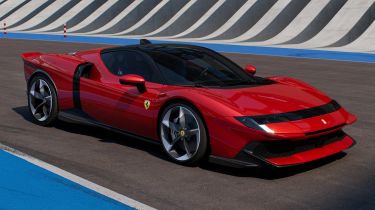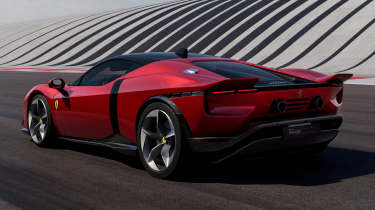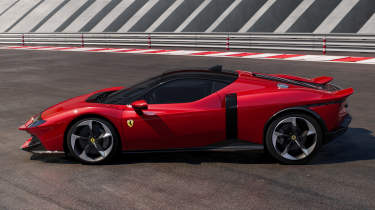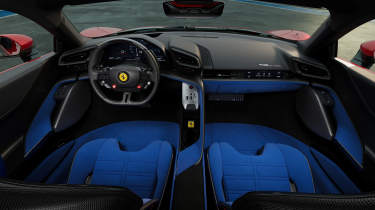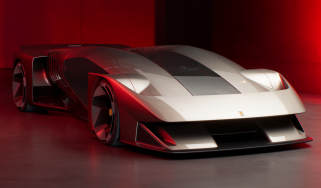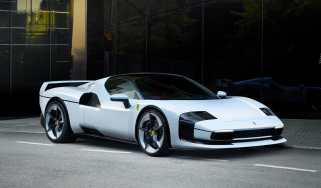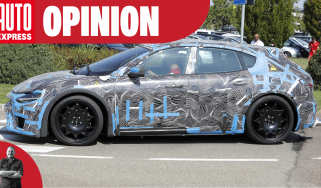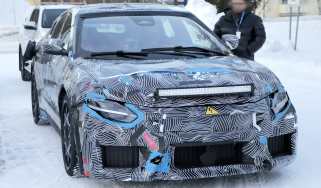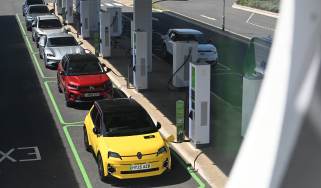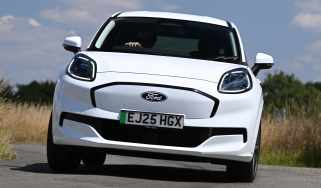New Ferrari 849 Testarossa: famous name, massive power and stunning looks
The new Ferrari 849 Testatrossa's plug-in hybrid twin-turbocharged V8 is good for 1,035bhp
One of the most iconic nameplates in Ferrari’s history is making a return in the shape of the new 849 Testarossa.
Within the brand's stable of mid-engined supercars, the Ferrari 849 Testarossa sits below the flagship, limited-run F80 and above the 296 GTB - acting as a successor to the SF90. As with all of those models, the 849 Testarossa comes with a plug-in hybrid powertrain, which Ferrari says has been ‘completely re-engineered’ compared with the unit used in the SF90.
The 849 Testarossa is expected to go on sale sometime in 2026 with two versions: the Berlinetta coupé and the drop-top Spider. Pricing is still some way off being revealed, although we expect it should comfortably eclipse the £376,000 and £418,000 Ferrari charged for the SF90 and SF90 Spider respectively.
If you're desperate to get your hands on a Ferrari but don't want to wait, you can buy a used Ferrari 488 GTB for just over £130,000 through our Buy A Car service.
Power and performance
Using a plug-in hybrid system derived from the SF90’s, the 849 Testarossa’s output combined with its V8 engine sits at 1,035bhp - 48bhp more than the SF90. The twin-turbocharged 4.0-litre V8 alone produces 818bhp and 842Nm of torque, more than twice the original Ferrari Testarossa’s 390bhp 490Nm output.
While the V8 is similar to the one found in the old SF90, Ferrari has gone to great lengths to rework it and extract more power. There are new cylinder heads, the engine block has been redesigned, new intakes and revised, larger turbochargers - developed from the F80 hypercar. The brand says the new Testarossa should sound like a Ferrari should “in all driving conditions”, thanks to a wider exhaust manifold and a new “gearshift strategy” taken from the wild SF90 XX Stradale. For good measure the Testarossa’s rev limit has been increased to 8,200rpm over the SF90’s 8,000rpm red line.
As with the SF90, there are three electric motors - two on the front axle and one at the rear – for a total of 217bhp. While that output remains the same as the SF90’s PHEV system, Ferrari has revised the entire set-up with more even and natural pedal feel under brake regeneration, plus improved thermal efficiency to widen the performance band of the electric motors. All-electric range (not that many Testarossa owners will likely care) stands at 15 miles, thanks to a 7.45kWh battery – unchanged from the SF90.
More important is how the 849 Testarossa goes down the road. The 0-62mph time stands at less than 2.3 seconds, which isn’t quite as fast as the F80’s 2.15-seconds, but it shaves 0.2 seconds off the SF90’s time. Top speed for the Testarossa is “more than 210mph”, according to Ferrari.
Chassis dynamics
At 1,570kg, the 849 Testarossa weighs exactly the same as the SF90, with weight distribution at 45 per cent at the front and 55 at the rear. The Spider’s folding metal roof has a weight penalty of 90kg - though the weight distribution is identical to the hard-top car’s.
Ferrari says it took the SF90 as a reference and focused on “increasing power, tyre grip and response”. The Testarossa features tweaks such as bigger brake discs and pads all round with improved cooling and pedal feel, 35 per cent lighter springs in the suspension, new tyres (there’s a selection of Michelin, Pirelli and Bridgestone), plus a smoother acceleration map within third gear.
The drive modes (which are selected by Ferrari’s usual ‘eManettino’ switch on the steering wheel) include eDrive, Hybrid, Performance and Qualify. In that sportiest Qualify mode, the 849 Testarossa can lap Ferrari’s Fiorano test track in just over one minute 17 seconds - around two seconds slower than the F80, but just 0.2 off the track-focused SF90 XX.
Aerodynamics play a big part in the Testarossa’s performance. The car can generate a downforce load of 415kg at 155mph - 25kg more than the SF90 – but despite this the cooling for the engine and brakes has been improved by 15 per cent (needed for the larger turbos), essentially meaning the air getting in isn’t wasted.
When it comes to the Testarossa’s downforce, 35 per cent is generated by the underfloor, but a significant amount is also done by the active rear wing, which is derived from the SF90 and the 296 GTB. It’s capable of switching between ‘low drag’ and ‘high downforce’ configurations in less than a second, helping to provide 100kg of downforce in the latter setting.
Exterior design
Wearing the Testarossa badge means the 849 has some big shoes to fill. Not least in relation to its looks with the original model really becoming a symbol for the eighties’ supercar scene, along with the Lamborghini Countach - which was revived in 2022 on the Aventador platform.
Unlike the Lamborghini, the 849 Testarossa very much looks to the future rather than the past in its design. Gone are the iconic side strakes for cooling, and, of course, there are no pop-up headlights here (which made way for fixed units on the 1994 512 M version of the Testarossa). There are some details traditional Ferrari fans might appreciate, however, with the double tail flicks above the rear lights taking inspiration from the 512 S. The geometric front end recalls Ferrari's “from the 1980s”, although the ‘horizontal fascia’ (the black bit connecting the headlights) is a design trait shared with modern Ferraris such as the F80 and 12Cilindri. The Testarossa sits on 20-inch, aero-optimised forged wheels.
The Testarossa Spider’s design is almost identical to the hard-top’s, but more impressive is the folding roof’s ability to go up and down in 14 seconds at speeds of up to 27mph.
Interior design
Inside the 849 Testarossa you’ll see a cockpit layout that at first glance looks very similar to the SF90. Despite the extra screen for the passenger, it’s very driver-orientated cabin, with almost a wraparound dash that incorporates the gear selector on the central arm. As with the SF90 there’s a tiny touch-sensitive screen in the middle for climate controls and a much larger digital display for the driver, compatible with Apple CarPlay and Android Auto.
The steering wheel looks typically Ferrari-like with the eManettino switch on the bottom right, integrated indicator buttons and pretty much everything else you’d expect on stalks in a ‘normal’ car. One thing that is new (well, sort of) is the physical engine start button, which replaces the SF90’s touch-sensitive operation. Two seat designs can be specced for the Testarossa - a ‘comfort’ one or a carbon-fibre racing bucket seat.
Personalising the 849 Testarossa even more is the Assetto Fiorano trim option. This provides an extra 30kg weight loss, thanks to extra use of carbon fibre and titanium - including 20-inch carbon wheels. The optional extra also adds larger front flicks on the bumper, a revised front floor to maximise downforce and twin tails at the rear. The suspension gets tweaked with stiffer, single-rate shocks with lighter and stiffer springs. You lose the choice of tyres, though, with Michelin Pilot Sport Cup2 tyres the only type of rubber available. Two colours can be had with the 849 Testarossa Assetto Fiorano: Bianco Cervino and Rosso Corsa (white and red).
What's in a name? Return of the Testarossa
By Paul Barker, editor, Auto Express
The timing is as interesting as anything. A fabled nameplate from the eighties, Testarossa conjures up memories of bedroom wall posters, Don Johnson’s Miami Vice company car and even the factually ropey Testarossa convertible raced on the Sega arcade game Outrun. But Ferrari has always resisted the temptation to evoke Testarossa nostalgia. Until now.
So the question is why it felt the need to put the classic name on its SF90 replacement. The 849 Testarossa is no shrinking violet in its own right, even if it’s not as distinctively individual as the original Testarossa was when the Pininfarina-designed car appeared at 1984’s Paris Motor Show. The way that car widened towards the rear to feed air to the rear-mid-mounted 4.9-litre flat-12 through those side strakes was particularly unique, whereas the 849 Testarossa feels very much an evolution of the SF90. Yes, it’s dramatic – and absolutely bonkers powerful – but not traffic-stoppingly different to what has gone before.
At least this time there’s a Testarossa drop-top. Despite Outrun’s narrative, there was only ever one Testarossa Spider, built for Fiat chairman Gianni Agnelli’s 20th anniversary in the role and sold in 2016 for $1.3m (£960,700).
Whether previously celebrity Testarossa drivers as diverse as Elton John, Mike Tyson, MC Hammer and Michael Jordan will be queuing up to own the 2026 version remains to be seen.
Did you know you can sell your car through Auto Express? We’ll help you get a great price and find a great deal on a new car, too.
Find a car with the experts

